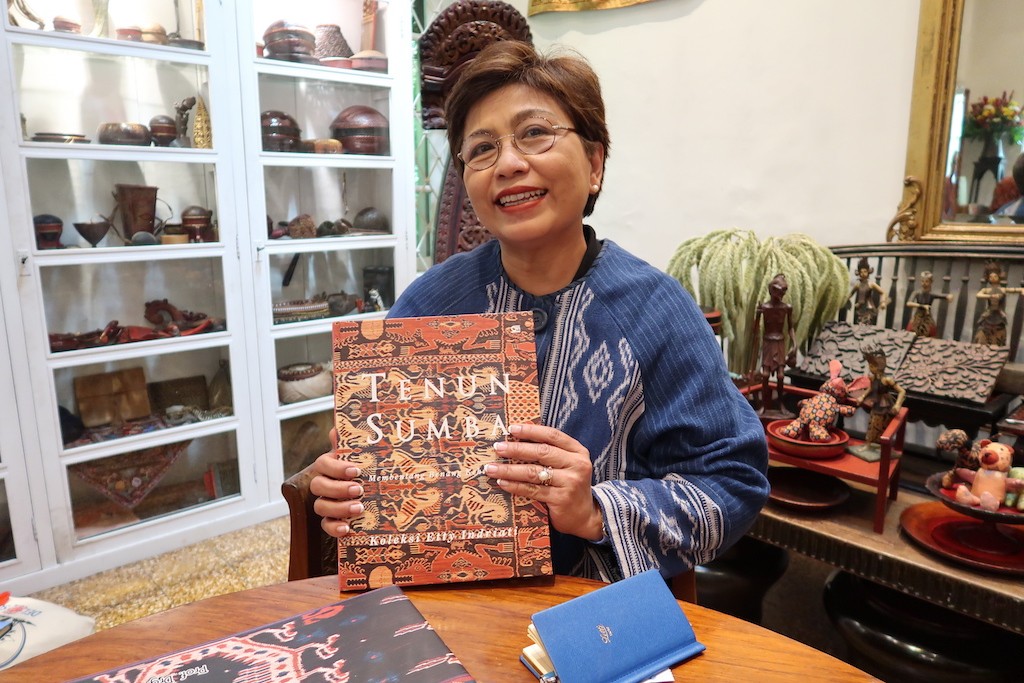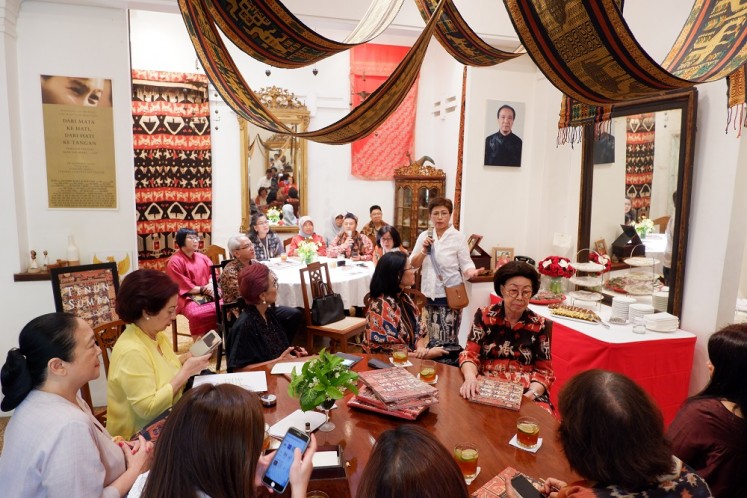Popular Reads
Top Results
Can't find what you're looking for?
View all search resultsPopular Reads
Top Results
Can't find what you're looking for?
View all search results'These are our symbols': Author champions Sumba's woven fabrics
Author Etty Indriati has just released her second book on Sumba's woven fabrics, showcasing her personal collection of the traditional hand-made cloth.
Change text size
Gift Premium Articles
to Anyone
“Sometimes, things like these are unplanned.”
For a few seconds, Etty Indriati gazed at nothing. She was in the middle of reminiscing over a series of events that brought her to the hand-woven fabrics of Sumba in East Nusa Tenggara, a subject that has taken up her mind and heart since 2015. “Around 25 years ago, my husband actually brought traditional fabrics home from the eastern part of Indonesia, but I frowned upon seeing the skull motif on them. ‘I saw enough skulls in my line of work; now I had to see them on a fabric?’, I thought,” Etty said. Her soft-spoken words, peppered with laughter, filled the serene room at BinHouse in Menteng, Central Jakarta, where we met on Nov. 19.
Born in Central Java’s Surakarta, Etty graduated from the School of Dentistry at Gadjah Mada University in Yogyakarta in 1987. After some time working at the university’s School of Medicine, she received the peculiar assignment of identifying bones. At the time, Yogyakarta was dealing with numerous cases of mutilation. “My former senior colleague was apparently overwhelmed and he gave me every single bone from the cases. But since I knew a thing or two about bones as a dentist, it was fairly easy to identify them,” she said.
The bones eventually took her to the field of anthropology at the University of Chicago. “I never go halfway,” she said. Afterward, Etty was frequently asked to join the National Police’s Disaster Victim Identification Unit, where she was tasked to identify skulls and bones.
When her interest in Sumba’s woven fabrics began to grow, she found that her knowledge and habit of identifying people was also applicable to studying fabrics. “As with humans, I would always try to find out where [the fabric] comes from, along with its anatomy, structure, material and motif,” she said.
In 2015, Etty decided to go to Sumba to do her research on the woven fabrics. By that time, she had written three books on batik and designer Edward Hutabarat encouraged her to collect woven fabrics to keep the tradition alive. Her visit to Sumba resulted in a massive collection, along with her first book on the subject, Beri Daku Tenun Sumba (Give Me Sumba Woven Fabrics), published one year later.
A second book, Tenun Sumba: Membentang Benang Kehidupan (Sumba Woven Fabrics: The Yarns of Life), was published by PT Gramedia Pustaka Utama in early November. It showcases 90 fabrics from her personal collection, along with detailed information on each one, the variety of motifs and their meanings, steps of making woven fabrics and a glimpse into traditional Indonesian textiles.
Etty Indriati (standing) at the launch of her book in Jakarta on Nov. 8, 2019. (PT Gramedia Pustaka Utama/File)Read also: New documentary highlights Sumba women's hopes and challenges
Etty told me that every place she went to in Sumba was unique. No area was less or more beautiful than the other, in relation to the popular notion that only the woven fabrics of East Sumba were of good quality.
She admired the blending of techniques and motifs from different parts of Sumba, saying that it shows the true tradition of Indonesia. “These artisans adopt new influences instead of just blindly adapting them,” she said, adding that traditional fabrics are among the oldest arts in the world.
She also shared certain motifs with the philosophies behind them, such as the unique dogs’ claws. “Apparently, dogs were part of a dowry from the bride’s family. So they featured the animal’s claws in a fabric,” said Etty. “It became a symbol of love.”
In the book, there are intricate descriptions for more than 30 motifs, which also show the richness of the culture in Sumba. Shrimps, for instance, represent brotherhood and unity, as they always travel in groups. They also hold a symbolic belief of life after death. Habak (flying house lizards) symbolize how people should always prepare for sudden and unexpected changes in life.
As part of the traditions, woven fabrics of Sumba will likely be made as long as the cycle of birth, marriage and death lasts. Etty said she hoped the fabrics could intrigue people to learn more about their meanings. “Try to find out from the artisan’s side of culture; don’t buy or wear fabrics just because it’s the trend. Go deeper, meet with the weavers, learn the process and hopefully we could appreciate them more,” she said.
“Sometimes we live solely based on the practical side, but knowing what lies behind them could also be exciting. It’s more meaningful to live with [knowledge],” Etty said. “The book is my attempt to make a written documentation of traditions and cultures, to not let them stay only in our memories. These are our symbols; this is who we are.”












